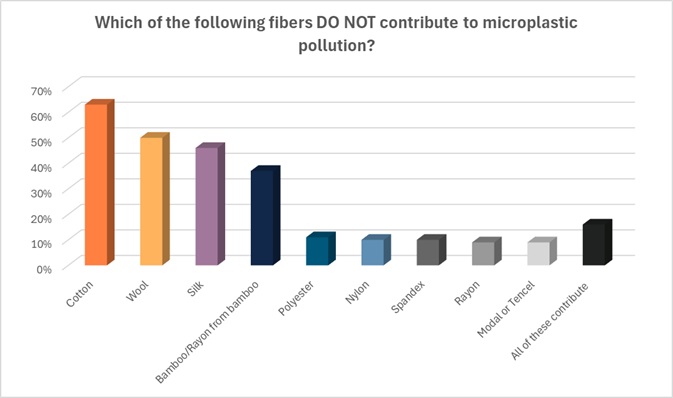When one thinks of Plastic Free July, the challenge to avoid all manner of plastic bottles, cups, and containers likely comes to mind. To be sure, that’s a central concern of the global project, which is a key initiative of the Plastic Free Foundation. But for those in the fashion industry, the challenge can be taken further to include plastic-free fashion, or apparel that doesn’t use fossil-fuel based materials like polyester, nylon and acrylic. Especially since questions are being raised about health and environmental issues associated with synthetic clothing.
Dr. Audrey Gaskins, associate professor, Rollins School of Public Health at Emory University, told the Lifestyle Monitor™ in an interview that synthetic clothing may be thought to be potentially problematic because it can be a source of exposure to endocrine disrupting chemicals (EDCs). Gaskins explained that the most studied EDCs found in clothing include PFAS (per- and polyfluoroalkyl substance), which are used to make fabrics water and stain-resistant (outdoor and performance wear), brominated flame retardants (children’s pajamas), phthalates (activewear, anti-odor clothing, and clothes with printed designs), and bisphenols, which are found in clothing with moisture-wicking or anti-static properties.
“All of these chemicals have been linked to a range of adverse health outcomes in men and women,” Gaskins explained to the Lifestyle Monitor™. She pointed out consumers are exposed to these chemicals from a wide variety of sources, including food and water.
However, Gaskins added, “If you have the means and option to purchase clothing in natural fibers versus [synthetic], this is advisable. We tend to think of kids as a particularly vulnerable population because their endocrine and other body systems are still developing. But in reality, there is research suggesting we all should be concerned given the range of adverse health outcomes that have been linked to EDCs.”
At Deploy, a London-based women’s wear brand, clothing is seen as “an interface for care,” said Tosin Trim, chief production officer, in an interview with the Lifestyle Monitor™.
“We prioritize 100 percent natural fibers not only for their breathable, luxurious feel, but also for their significantly lower, long-term environmental impact compared to petrol chemical-based synthetics,” Trim told the Lifestyle Monitor™. “Polyester, nylon, acetate for example, are all derived directly from fossil fuels. They not only require much stronger ‘cocktails’ of chemical dyestuff, but they also release microplastics into water systems both in manufacturing, pre-consumer stages and with every wash after sales. They continue to release ‘forever chemicals’ after disposal, [which is] toxic to soil, water and air when landfilled and/or incinerated.”
“In contrast, natural fibers are biodegradable, renewable and – when responsibly sourced – significantly reduce chemical use, from agriculture in the form of synthetic pesticides and fertilizers to dyeing and finishing,” Trim said. “Furthermore, the natural fibers tend to use much less chemicals for ‘performance features’ and are thereby much kinder to the skin — the biggest human organ.”
In addition to health concerns, brands might consider incorporating more cotton into their collections because the clear majority of consumers (74 percent) say cotton/cotton blends are their favorite fabric/fiber to wear, according to the Cotton Incorporated 2025 Lifestyle Monitor™ Survey (n=500). And nearly 3 in 10 consumers (30 percent) are actually bothered that brands are using synthetic fibers in their clothing.
Consumers are also concerned about microplastic pollution that stems from synthetic textiles. Consider that 7 in 10 are either somewhat or very aware of microplastic pollution, according to the Cotton Incorporated 2025 Microplastics Survey (U.S., n=974). Their major concerns are microplastics getting into the products we eat and drink (69 percent), as well as damaging fish and other marine life (67 percent).
Additionally, consumers also accurately identify synthetic fibers as contributing to microplastic pollution, and most often cite cotton (63 percent) as a fiber that does not contribute, according to the 2025 Microplastics Survey.

Consumer concern about microfiber pollution is not without warrant. Leading researchers and Cotton Incorporated released a study in Nature Communications that revealed synthetic clothing contributes 7.4 million metric tons of plastic pollution every year. This is the equivalent weight of 820 Eiffel Towers entering the environment year after year.
“The impact of synthetic garments on plastic pollution is staggering, with at least ten times more leakage than cotton clothing,” said Jesse Daystar, Ph.D., vice president and chief sustainability officer at Cotton Incorporated. “Designing with natural fibers like cotton is one of the key strategies to reducing plastic leakage from the apparel industry.”
Gaskins explained another health reason as to why exposure to microplastics is a concern when wearing man-made fabrics.
“Microplastics are so small they get everywhere in our body,” Gaskins said. “Some are eliminated as waste, but we find them in virtually all body systems and organs.”
An article in Harvard Medicine, the magazine of Harvard Medical School, describes how researchers have found microplastics throughout the human body, “including in the blood, saliva, liver, kidneys and placenta.” The article goes on to say lessons from the field of environmental toxicology raise flags about cancer and reproductive issues.
“Studies in cell cultures, marine wildlife and animal models indicate that microplastics can cause oxidative damage, DNA damage and changes in gene activity, known risks for cancer development,” the Harvard Medicine article states.
Deploy’s Trim said the company is “acutely aware” of the long-term effects of plastic-based textiles – not just in the form of environmental degradation, but in microplastic pollution that now threatens marine life and is entering our food chain.
“The health implications are increasingly clear, and we believe fashion must play a more proactive role in addressing them,” Trim stated. “A nature-based, traceable approach to circular fiber, textiles and garment design and production is not just preferable, it’s essential.”
